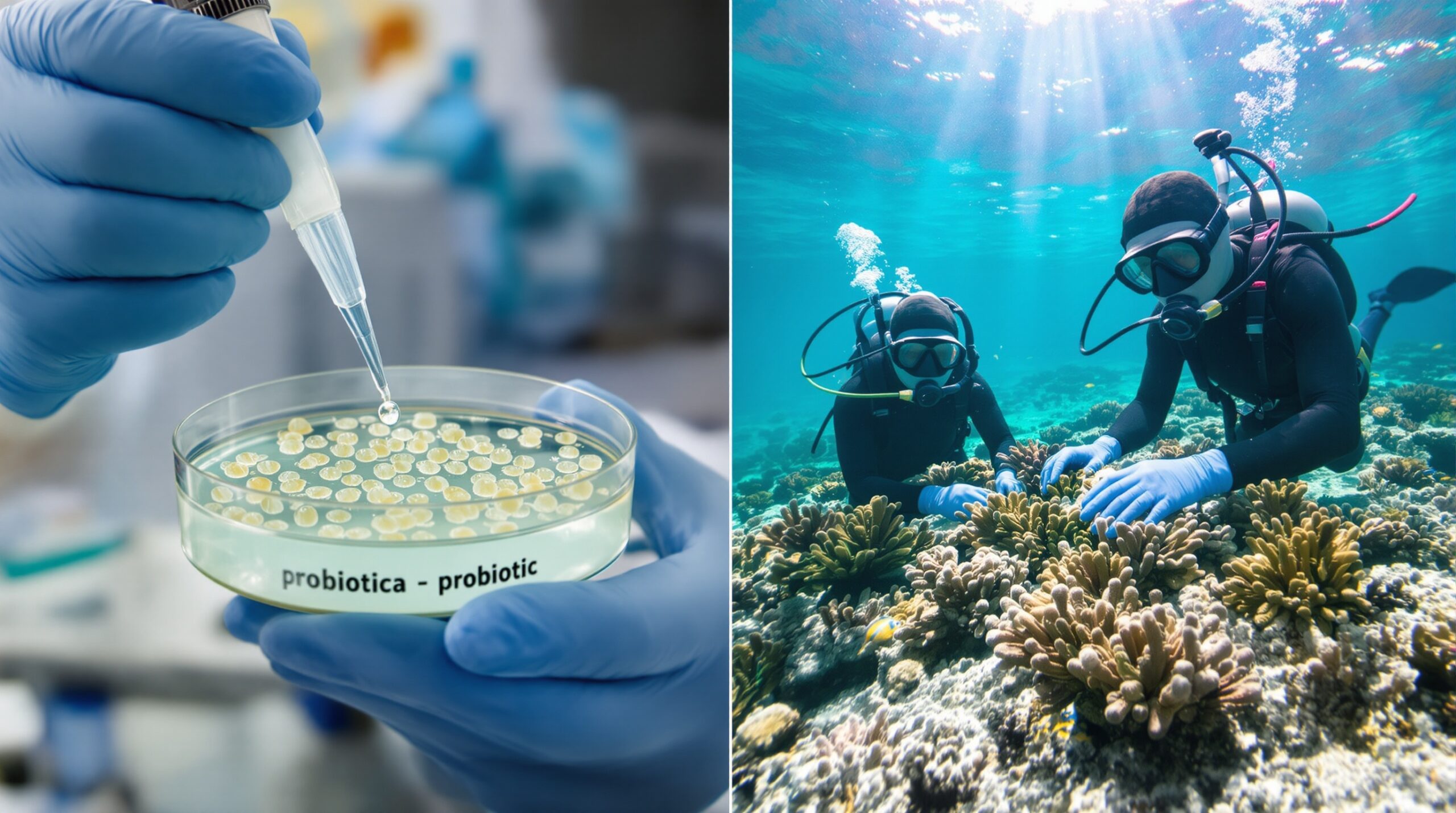Coral restoration science is advancing rapidly, and probiotics are emerging as a powerful ally. Researchers now culture coral larvae in hatcheries and augment them with beneficial bacteria. These microbial partners stabilize larval health and speed early development. Controlled trials report faster settlement, greater survival, and stronger stress tolerance. Together, these outcomes point to a practical pathway for rebuilding degraded reefs.
Why Coral Reefs Need Help Now
Reefs face warming seas, acidification, pollution, and intensifying disease outbreaks. Heat waves trigger bleaching, which can kill coral hosts outright. Storm damage and sedimentation also reduce recruitment of new coral generations. Natural recovery often lags behind accelerating disturbances. Therefore, active restoration tools that boost early life stages are becoming essential.
What Lab-Grown Coral Larvae Really Are
Scientists collect gametes during mass spawning events and fertilize them under controlled conditions. The resulting larvae develop in tanks with stable temperature and water quality. Teams then guide settlement onto specially designed substrates. These juveniles continue growing in nurseries until they can survive on reefs. The approach creates reliable cohorts for restoration at meaningful scales.
Probiotics for Corals: Concept and Background
Healthy corals rely on diverse microbes that support nutrition and disease defense. The “Beneficial Microorganisms for Corals” framework formalized this idea for interventions. Probiotics are carefully selected bacteria that enhance coral fitness under stress. They can produce vitamins, neutralize reactive oxygen, and deter pathogens. Their addition complements the coral’s own microbiome rather than replacing it.
How Researchers Build Probiotic Consortia
Teams isolate candidate strains from resilient corals and the surrounding seawater. They screen strains for antimicrobial activity, oxidative stress protection, and nutrient cycling traits. Genomic analyses help exclude harmful genes and assess biosafety. Compatibility with coral larvae and algal symbionts receives special attention. This careful curation supports predictable performance in complex hatchery systems.
Controlled Trials and Key Findings
Hatchery and mesocosm trials show consistent benefits across species and conditions. Probiotic-treated larvae settle more quickly and in greater numbers than controls. Juveniles exhibit lower disease incidence and better tissue condition. Under thermal stress, survival remains higher with probiotic support. These results suggest microbiome engineering can accelerate early reef recovery steps.
Faster and More Reliable Settlement
Settlement marks the transition from free-swimming larvae to attached juveniles. Probiotic consortia appear to prime larvae for this shift. Treated larvae respond more readily to settlement cues, including crustose coralline algae signals. Researchers observe earlier attachment and more uniform settlement windows. This reliability helps planners align nursery schedules and deployment logistics.
Improved Survival and Thermal Tolerance
Heat stress is the dominant threat to early coral life stages. Probiotics can reduce oxidative damage produced during thermal spikes. Treated juveniles maintain healthier tissues and more stable symbiotic algae densities. Survival advantages persist across repeated stress exposures in trials. The pattern supports targeted microbiome support as a resilience tool.
Lower Disease Susceptibility
Opportunistic bacteria often proliferate in nursery systems and disturbed reefs. Probiotic strains compete with pathogens for space and resources. Many strains also secrete compounds that inhibit harmful microbes. In trials, disease signs appear less frequently in treated cohorts. Reduced disease pressure helps more juveniles reach outplanting size.
Microbiome Stability During a Vulnerable Window
Larvae and recent settlers experience major physiological changes that can destabilize microbiomes. Probiotics help stabilize community composition during this transition. Treated corals show more functional redundancy within their microbial partners. This stability correlates with consistent growth and lower mortality. The effect creates a smoother trajectory toward robust early juveniles.
Enhanced Symbiont Uptake and Nutrition
Coral larvae must acquire photosynthetic symbionts to thrive. Some probiotic strains appear to facilitate this uptake. They may produce signaling molecules or vitamins that support symbiosis establishment. Trials report earlier symbiont acquisition and steadier chlorophyll levels. Better nutrition translates into faster growth and thicker tissues.
Why Probiotics Accelerate Recovery at Scale
Restoration programs need high yields of healthy juveniles for outplanting. Probiotic support raises the fraction of larvae that settle and survive. Stronger juveniles withstand transport, handling, and the rigors of early reef life. Faster growth shortens nursery time, reducing costs and risks. Collectively, these gains scale into more living coral cover on reefs.
Practical Considerations and Risks
Probiotic use requires careful stewardship and documentation. Strains should originate from reef environments and pass biosafety checks. Persistence on reefs must not disrupt native microbial communities. Regulatory approvals and biosecurity protocols guide responsible deployments. Long-term monitoring helps verify benefits and identify any unintended outcomes.
Integration with Other Restoration Interventions
Probiotics work best alongside complementary tools. Selective breeding increases thermal tolerance in broodstock lines. Shading, controlled flow, and heat-hardening support juvenile conditioning. Engineered substrates deliver chemical cues that encourage settlement and growth. Combining approaches compounds benefits and diversifies resilience pathways.
Evidence Gaps and Ongoing Research
Field validations across diverse reef settings remain a priority. Researchers are testing the persistence of benefits after outplanting. Multi-year studies will clarify impacts on reproduction and lifetime fitness. Teams also examine how probiotics interact with local stressors. Transparent data sharing will accelerate learning across programs and regions.
Standardization and Quality Assurance
Restoration facilities benefit from standard operating procedures and quality controls. Clear definitions for probiotic identity and dose improve reproducibility. Environmental DNA and microbiome profiling verify colonization and stability. Common reporting frameworks help compare outcomes across trials. These practices build confidence for funders, regulators, and communities.
Socioeconomic and Policy Dimensions
Accelerated recovery has ecological and economic value for coastal societies. Tourism, fisheries, and shoreline protection depend on healthy reefs. Policy support can align permitting, funding, and monitoring requirements. Transparent engagement with local stakeholders strengthens project legitimacy. Ethical sourcing and cultural considerations should guide restoration plans.
What Success Could Look Like
Programs could produce larger pulses of robust juveniles each spawning season. Outplanted corals would survive at higher rates under variable conditions. Reefs would regain structural complexity faster, aiding fish and invertebrates. Managers could target recovery strategically across climate refugia and impacted sites. Consistent results would justify continued investment and expansion.
Conclusion: A Promising Path Toward Resilient Reefs
Lab-grown coral larvae enhanced with probiotics show measurable advantages in controlled trials. Faster settlement, stronger survival, and disease resistance drive recovery. Integration with established restoration tools can multiply these gains. With careful safeguards, this approach offers reefs a fighting chance.


